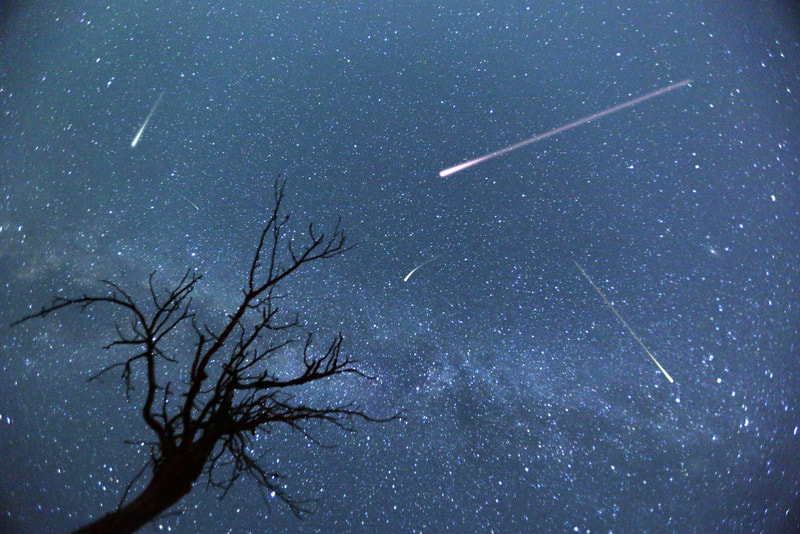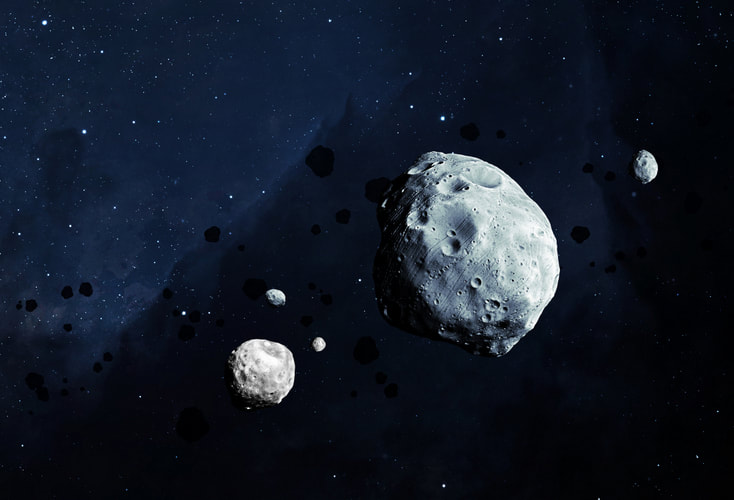In this module, you’ll learn all about asteroids, comets and meteors. The first section will help you learn the difference between these and other related objects, giving you an overview and summary of their characteristics. Next, there will be a discussion about observing meteor showers, with sections on timing, the radiant point and the ZHR, and other tips. Following that, we’ll go through Halley’s comet and many other famous cases, before the module concludes with a section about the dangers of asteroids. Here we’ll look at incidents in the past and what the future might hold.
Both asteroids and comets were formed around 4.5 billion years ago, when our Solar System was relatively young. Asteroids, inactive bodies made of carbon, rock and/or metals such as nickel and iron, were formed closer to the Sun, while comets, made of ices and dirt and up to several miles in diameter, were formed further from the Sun. As comets orbit the Sun, they get closer to it with each orbit. As they do so, their ice begins to melt and vaporize, which causes them to have tails of dust and gas. When comets are far away from the Sun, it is difficult to distinguish them from an asteroid, but when they are closer to the Sun, their tail gives them away instantly. These tails can be up to thousands of miles long and are sometimes visible from Earth.
It is thought that comets have been fundamental in shaping our Earth and life as we know it. They struck the Earth billions of years ago, creating changes to the atmosphere, the early oceans and the climate. There is even speculation that they brought carbon-based molecules to Earth for the first time, which could be responsible for the beginnings of life on Earth.
There is evidence that asteroids have also hit Earth in the past. Asteroids and smaller fragments called meteoroids are usually too small to pass through the Earth’s atmosphere, and are vaporized. They end up burning, and as they burn, they let off a trail of light, and are known as a ‘shooting star’ or meteor.
Large asteroids that pass through the Earth’s atmosphere can crash to Earth and cause damage. It is thought a large asteroid hitting Earth was what led to the extinction of dinosaurs some 65 million years ago. Any bodies that manage to break through the Earth’s surface, survive the journey, and crash to Earth are known as meteorites.
It is thought that comets have been fundamental in shaping our Earth and life as we know it. They struck the Earth billions of years ago, creating changes to the atmosphere, the early oceans and the climate. There is even speculation that they brought carbon-based molecules to Earth for the first time, which could be responsible for the beginnings of life on Earth.
There is evidence that asteroids have also hit Earth in the past. Asteroids and smaller fragments called meteoroids are usually too small to pass through the Earth’s atmosphere, and are vaporized. They end up burning, and as they burn, they let off a trail of light, and are known as a ‘shooting star’ or meteor.
Large asteroids that pass through the Earth’s atmosphere can crash to Earth and cause damage. It is thought a large asteroid hitting Earth was what led to the extinction of dinosaurs some 65 million years ago. Any bodies that manage to break through the Earth’s surface, survive the journey, and crash to Earth are known as meteorites.
A fireball is a very bright meteor, usually brighter than magnitude -4. Fireballs and meteors are measured according to brightness using the magnitude scale, which compares their brightness to other objects in the sky.
Meteors, Comets, and Asteroids
Fireballs may also have color. Reported colors range from red to bright blue, and even violet is occasionally reported. The color is often affected by the composition of the meteoroid, as when it is vaporized, the colors are released. For example, when magnesium is vaporized, it shows as a bluish white color, while sodium becomes bright yellow and nickel shows as green. Speed also has an effect, with slow meteors often orange or red, and fast meteors commonly being blue.
Fireballs often have trains or smoke trails behind them. Trains are glowing air molecules, left behind after the meteor has passed, and they generally last a few seconds, though trains remaining up to a few minutes have been recorded. These trains are more common with fast-traveling meteors that are 65 miles or more above ground, and are more often seen at night. In contrast, smoke trails are more often seen in daylight, and with meteors traveling under 50 miles altitude. These appear very similar to trails left behind airplanes, and can be either dark or light in color.
Fireballs may also have color. Reported colors range from red to bright blue, and even violet is occasionally reported. The color is often affected by the composition of the meteoroid, as when it is vaporized, the colors are released. For example, when magnesium is vaporized, it shows as a bluish white color, while sodium becomes bright yellow and nickel shows as green. Speed also has an effect, with slow meteors often orange or red, and fast meteors commonly being blue.
Fireballs often have trains or smoke trails behind them. Trains are glowing air molecules, left behind after the meteor has passed, and they generally last a few seconds, though trains remaining up to a few minutes have been recorded. These trains are more common with fast-traveling meteors that are 65 miles or more above ground, and are more often seen at night. In contrast, smoke trails are more often seen in daylight, and with meteors traveling under 50 miles altitude. These appear very similar to trails left behind airplanes, and can be either dark or light in color.
3.1.3 In summary
Asteroid
Asteroid
- Made of rock, carbon, and/or metals such as nickel and iron
- Range in size – small boulder size to diameters of hundreds of miles
- Orbits the Sun
- Made of ice and dirt
- Several miles in diameter
- Melting ice as their orbits get closer to the Sun create dust and gas tails that can be thousands of miles long
- Meteors brighter than magnitude -4
- May have trains or smoke trails
- A particle from an asteroid or comet, orbiting the Sun.
- When a meteoroid is vaporized on entering the Earth’s atmosphere, it begins to burn and let off bright light. At this point it is known as a meteor or a shooting star.
- When a meteoroid survives going through the Earth’s atmosphere and crashes to Earth.
- <<<<<<<Astronomy




